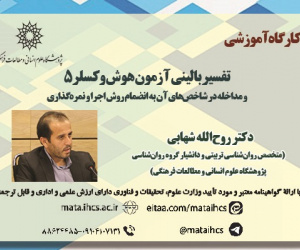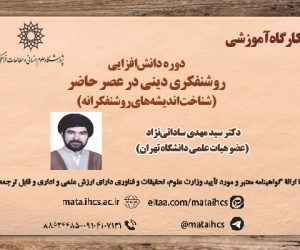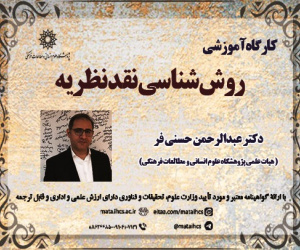اثربخشی برنامۀ توانمندسازی زناشویی مبتنی بر طرحواره های مثبت بر رضایت زناشویی و تمایزیافتگی زوجین (مقاله علمی وزارت علوم)
درجه علمی: نشریه علمی (وزارت علوم)
آرشیو
چکیده
هدف پژوهش حاضر بررسی اثربخشی برنامه توانمندسازی زناشویی مبتنی بر طرحواره های مثبت بر رضایت زناشویی و تمایزیافتگی زوجین بود. روش پژوهش نیمه آزمایشی با طرح پیش آزمون، پس آزمون و پیگیری با گروه گواه بود. در این پژوهش، از بین زوجین ساکن اراک در زمستان سال 1402، 24 زوج به روش نمونه گیری در دسترس انتخاب و به روش تصادفی در دو گروه آزمایش و گواه جای دهی شدند. برای گردآوری داده ها از پرسشنامه رضایت زناشویی انریچ، پرسشنامه تمایزیافتگی خود اسکورن و فریدلندر و فرم کوتاه پرسشنامه طرحواره های ناسازگار اولیه یانگ استفاده شد. زوجین گروه آموزش به مدت 11 جلسه 90دقیقه ای در جلسات آموزشی برنامه توانمندسازی زناشویی مبتنی بر طرحواره های مثبت شرکت کردند. نتایج تحلیل واریانس چندمتغیری نشان داد آموزش برنامه توانمندسازی زناشویی مبتنی بر طرحواره های مثبت بر رضایت زناشویی و تمایزیافتگی زوجین اثربخشی معناداری داشته است و این نتیجه در دوره پیگیری 45روزه نیز پایدار بود. بنابراین، می توان گفت برنامه توانمندسازی زناشویی از روایی لازم برای افزایش تمایزیافتگی و رضایت زناشویی زوجین به عنوان یک برنامه پیشگیرانه سطح اول برخوردار است.The Effectiveness of Marital Empowerment Program Based on Positive Schemas for Imporving Marital Satisfaction and Differentiation of Couples
The putpose of this study was to investigate the effectiveness of the marital empowerment program based on positive schemas for improving marital satisfaction and differentiation among couples. The research method was quasi-experimental using a pre-test, post-test and follow-up design with a control group. In this study, from among couples residing in Arak, Iran 2024, 24 couples were selected using convenience sampling and were randomly assigned to either an experimental or a control groups. Data collection was performed using Enrich's Marital Satisfaction Questionnaire, the Skowron and Friedlander's self Differentiation Questionnaire, and the Young Schema Questionnaire- short form. The couples in training group participated in the educational sessions of the marital empowerment program based on positive schemas for 11, 90 minute sessions. The results of multivariate variance analysis showed that the training of the marital empowerment program based on positive schemas had a significant effect on marital satisfaction and couples' differentiation, and this result was stable in the 45-day follow-up period. Therefore, the marital empowerment program has the necessary validity to increase the differentiation and marital satisfaction of couples as a first-level preventive program. Introduction Given the importance of the family institution, therapists constantly seek to utilize various interventions, including schema therapy and other schema-based interventions, to help couples achieve satisfying and stable relationships. Although most of these interventions primarily focus on early maladaptive or negative schemas (Stevens & Roediger, 2023), in 2012, Lockwood and Perris introduced the concept of early adaptive or positive schemas as a positive complement to early maladaptive schemas in Young's (2003) approach. Considering that, on the one hand, research findings indicate that these schemas have a significant role in the efficiency and psychological well-being of individuals. On the other hand, positive clinical psychology emphasizes that interventions focused on enhancing positive aspects can be as successful as interventions based on reducing negative aspects in improving psychological problems and mental health issues (Louis et al, 2018), The aim of the present study was to investigate the effectiveness of a marital empowerment program based on positive schemas on marital satisfaction and differentiation. The research hypotheses of the study were: Marital empowerment program based on positive schemas is effective on couples' marital satisfaction. Marital empowerment program based on positive schemas is effective on couples' differentiation. Method This research is quasi-experimental with a pre-test-post-test design with a non-equivalent control group and a 45-day follow-up period. The statistical population included all couples residing in Arak, Iran, in 2024, from whom 24 couples were selected through convenience sampling and according to the inclusion criteria of the study and were randomly assigned to two experimental and control groups (12 couples in each group). In this study, three questionnaires were used: the Enrich marital satisfaction questionnaire, the Self-differentiation questionnaire and the short form of the Early maladaptive schemas questionnaire. Members of the experimental and control groups completed these questionnaires in three stages: The pre-test stage, before the start of the sessions; the post-test stage, one week after the last training session; and the follow-up stage, 45 days after the end of the sessions. The couples in the experimental group participated in 11 sessions of 90 minutes in the training sessions of the marital empowerment program. These sessions were held weekly and in groups. The marital empowerment program based on positive schemas is a level one preventive program that is based on the components of positive schemas identified by Mehrtalab et al. (2024) and using the method of documentary study and studying the theoretical foundations and available sources about positive schemas developed by the researchers and its content validity coefficient was calculated using the Lawshe method 0.93. Results The results of the Shapiro-Wilk test showed that the scores of the differentiation variable in the education group ( z =0.90, df=10, p =0.23) and the control group ( z =0.93, df=10, p =0.53), as well as the marital satisfaction variable in the training group ( z =0.95, df =10, p =.87) and the control group ( z =0.96, df=10, p =.83) had a normal distribution. The results of Levene's test showed that the significance level for the differentiation variable in the pre-test ( F =0.33, df 1,2 =1/18 , p =0.57), post-test ( F =1.65, df 1,2 =1/18, p =0.21) and follow-up ( F =0.69, df 1,2 =1/18, p =0.89) and for the marital satisfaction variable in the pre-test ( F =0.01, df 1,2 =1/18, p =0.21), post-test ( F =0.002, df 1,2 =1/18, p =0.91) and follow-up ( F =0.03, df 1,2 =1/18, p =0.84), which is higher than 0.05 and indicates homogeneity of variance between groups. The results of Mauchly's test on within-group sphericity showed that for the differentiation variable ( Mauchly's w =0.96, chi-square =0.66, df=2, p =0.71) and for the marital satisfaction variable ( Mauchly's w =0.93, chi-square =1.21, df=2, p =0.54), it can be concluded that sphericity is assumed. The results of the Box , s M test also showed that the null hypothesis of homogeneity of the covariance matrix had been observed ( Box , s M =38.70, F =1.19, df 1,2 =21 and 671191, p =0.25). The results of the Pillai's Trace test showed that there was a significant multivariate effect for time (pre-test, post-test and follow-up) ( F 4,15 =60/85, V =0.94, p >0.001). There was also a significant multivariate effect between groups (training group and control group) ( F 2,17 =51.24, V =0.86, p >0.001) and the results for the interaction between groups and time also showed a significant multivariate effect ( F 4,15 =54.27, V =0.94, p >0.001). The results of the within-group analysis of variance also showed a significant difference in time (pre-test, post-test, and follow-up) for the differentiation variable ( F 1/92,34/66 =76.97, p >0.001, V =0.81) and marital satisfaction ( F 1/87,33/67 =51.36, p >0.001, V =0.74). There was also a significant interaction between measurement times (pre-test, post-test, and follow-up) and groups (training and control) for the differentiation variable ( F 1/92,34/66 =42.27, p >0.001, V =0.70) and marital satisfaction ( F 1/87,33/67 =54.77, p >0.001, V =0.75). The mean and standard deviation of the dependent variables of differentiation and marital satisfaction of couples in the training group and the control group in the three time periods of pre-test, post-test, and follow-up are shown in Table 1. Pairwise comparison of the means and adjusted standard deviations of the dependent variables according to the separation of measurement times are presented in Table 2. It shows that there was a significant difference in the differentiation and marital satisfaction variables between the mean scores of the pre-test and post-test stages, but there was no significant difference between the mean scores of the post-test and follow-up stages of the differentiation and marital satisfaction variables. Table 1 Mean and Standard Error of Interaction between Group and Time for Dependent Variables Differentiation Marital satisfaction group Time M SD M SD training Pre-test 140.25 1.23 139.50 0.70 Post test 158.90 1.40 158.55 0.81 Follow up 155.70 1.61 151.30 1.45 control Pre-test 142.10 1.23 140.45 0.70 Post test 145.10 1.40 139.65 0.81 Follow up 144 1.61 143.05 1.45 Table 2 Pairwise Comparison of Mean and Adjusted Standard Deviation of Variables Dependent on the Separation of Measurement Times Variables group MD SD P Differentiation Pre-test – Post test -10.82 1 0.001 Pre-test– Follow up -8.67 0.91 0.001 Post test – Follow up 2.15 0.84 0.06 Marital satisfaction Pre-test – Post test -9.12 0.84 0.001 Pre test –Follow up -7.2 0.93 0.001 Post test – Follow up 1.92 1.05 0.25 Conclusion The aim of the present study was to investigate the effectiveness of a marital empowerment program based on positive schemas for enhancing marital satisfaction and differentiation among couples. The results showed that the marital empowerment program based on positive schemas had a significant effect on marital satisfaction and differentiation of couples in the training group compared to the control group, and this effect was also stable in the follow-up phase. The lack of similar research on the effectiveness of positive schemas on components related to marital life makes it difficult to compare the results of the present study with previous research. However, the effectiveness of the marital empowerment program on the level of marital satisfaction of couples can be explained by the fact that this program is based on the basic psychological needs and positive schemas of self-acceptance, stable attachment, trust, empathetic attention, self-control, self-direction, success, self-confidence, assertiveness, health and safety, healthy boundaries, self-compassion, and self-care, which the role of each of schemas in increasing marital satisfaction of couples has been confirmed based on theoretical and research foundations. In addition, the results of the research indicated the effectiveness of the training of the marital empowerment program based on positive schemas on the differentiation of couples. In explaining this finding, it can be said that, according to Bowen (2000), differentiation, as the key to mental health, expresses the ability of individual to create a balance between rational and emotional processes on the one hand and independence and intimacy on the other hand; any factor that can affect the intrapsychic and interpersonal dimensions of differentiation will be effective on the level of differentiation of couples. Accordingly, the positive schemas of stable attachment, basic health and safety, healthy boundaries, self-control, self-direction, and self-compassion have been effective in increasing couples' differentiation by affecting the intrapsychic and interpersonal dimensions of differentiation. Therefore, it can be said that the couples empowerment program emphasizes and focuses on forming and strengthening a mature, empathetic, and accepting mindset and attitude in couples through activating and strengthening positive schemas. According to the results obtained, this program has the necessary educational validity to increase the differentiation and marital satisfaction of couples as a level one preventive program. Among the limitations of the current study, we can point to the difficult access to the target statistical population due to the reluctance of men to participate in group training sessions, the use of convenience sampling, and, as a result, the limitation of the research sample to volunteer couples residing in the city of Arak. Accordingly, it is suggested that, in order to increase the generalizability of the results, the effectiveness of the marital empowerment program based on positive schemas be evaluated in different research samples. Ethical Consideration Compliance with Ethical Guidelines : All ethical issues were compiled based on ethical committee. Authors’ Contributions : This article is extracted from the doctoral thesis of the first author. Extraction, preparation, editing of the article was done by the first author. The second and third authors are the supervisor and thesis adviser, respectively Conflict of Interest : The authos declare no conflict of interests. Funding: The study had no financial support. Acknowledgment: The authors would like to thank all participants for their time and contribution to the Study.







